Some places of interest that could be seen within a day’s outing from our home that you may find interesting
Caerlaverock Castle

A mile from our home is Caerlaverock Castle, a mediaeval stronghold built in 1270. The remains of the original castle built in 1220 lies nearby. Attacked, ravaged and repaired many times, the Maxwell family managed to stay in possession until 1640. A visit for any little boy, no matter their age!
Caerlaverock Nature Reserve
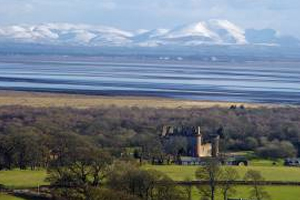
This amazing expanse of wilderness is one of the few places in Europe where growth and erosion of saltmarsh continues unhindered by man, extending over 8000 hectares and is covered and uncovered by the sea twice a day. Thousands of wildfowl and waders find refuge on the vast mudflats of the Solway during winter. Access is free of charge with walks through woodland and open merse.
Wetland Wildfowl Trust
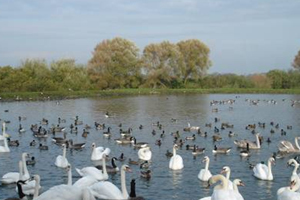
Caerlaverock Wetland Centre is a spectacular 1,400 acre wild reserve situated 1.5 miles from our home where ponds have been dug for the natterjack toads and earth ridges have been built along the roadways that allow bird watchers to reach the hides undetected. In excess of 25 000 Svalbard barnacle geese return each October from the High Arctic archipelago of Svalbard to stay until April on the Solway’s salt flats and merses. During summer, explore the rolling wildflower meadows, watch ospreys hunting over the Solway and spot barn owls and badgers. It is a truly beautiful coastal landscape and the wide skies and amazing light conditions provide sights and sounds of nature like no where else. Bring your camera!
Old Blacksmiths Shop
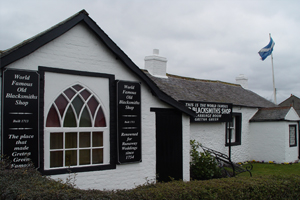
Old Blacksmiths Shop, Gretna Green is famous the world over for runaway marriages that began in 1753 when an English Act of Parliament stated that consent to marriage had to be given by the parents if either couple were under 21. This Act did not apply in Scotland, where it was possible for boys to get married at 14 and girls at 12 years old with or without parental consent. There is an anvil and coach museum to tell the Gretna Green story, a tartan and tweed shop, excellent restaurant, coffee house and a tourist information centre on site.
www.undiscoveredscotland.co.uk/gretna
Highland cattle

Highland cattle (“Beasties”) are a Scottish breed developed in the Scottish Highlands and Western Isles of Scotland. We found these at Gretna Green next to the Old Blacksmiths Shop car park. The Belted Galloway (“Belties”) is a heritage beef breed originating from Galloway in the west side of southern Scotland, adapted to living on the poor upland pastures and windswept moorlands of the region. It is the white belt of colour that gives them their name.
Old Mortality by Sir Walter Scott

Old Mortality, considered one of Sir Walter Scott’s best novel, is set in the period 1679-89 in south west Scotland. The novel takes its title from the nickname of Robert Paterson, a Scotsman of the 18th century who late in life decided to travel around Scotland re-engraving the tombs of 17th century Covenanter martyrs. A short walk from Hutton Lodge is the churchyard of Caerlaverock parish in which the remains of Robert Patterson lie.
www.en.wikipedia.org/wiki/Old_Mortality
Devil’s Porridge Exhibition, Eastriggs

Eastriggs is a village about 15 minutes drive from our home where the “Greatest Munitions Factory on Earth” was built during 1915. Britain was losing the Great War through the lack of munitions supplies and so 30,000 women and men came from the colonies to work in this massive factory to manufacture Cordite for firing artillery shells. Cordite is a paste substance made from nitro-glycerine and nitro-cotton that Sir Arthur Conan Doyle, creator of Sherlock Holmes, described the ‘Devil's Porridge’.
Brow Well
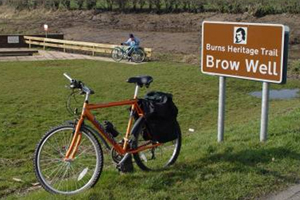
3 miles along the road from our home alongside the Solway Firth lies Brow Well, purported to be a health spa containing water with certain healing qualities. It was visited in 1796 by the Bard of Scotland, Robert Burns at the age of 37 when suffering from a severe illness. It didn’t seem to do him much good as he died soon after drinking from the well. Best to sample the whisky and leave the wells alone!
Ruthwell Cross
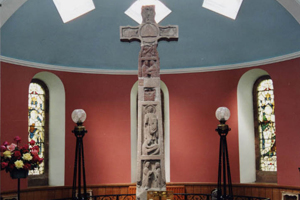
The Ruthwell Cross features the largest surviving Anglo-Saxon reliefs of any sort and has inscriptions in both Latin and, more unusually for a Christian monument, the runic alphabet, the latter containing lines similar to lines 39-64 of The Dream of the Rood, an Old English poem. It is 18 feet (5.5 metres) high. Smashed by Presbyterian iconoclasts in 1664, the pieces were restored in 1818 by Henry Duncan and moved to its current location in Ruthwell church in 1887.
Admission is free.
www.en.wikipedia.org/wiki/Ruthwell_Cross
Ruthwell Savings Bank

In 1810, Rev. Dr. Henry Duncan, minister, author, antiquarian, geologist, publisher, philanthropist, artist and businessman opened the world's first commercial savings bank in Ruthwell village about 5 miles from our home, paying interest on investors’ savings. A fascinating display at the small Savings Bank Museum tells the story of early home savings in Britain and where modern banking all started.
Admission is free.
Dumfries
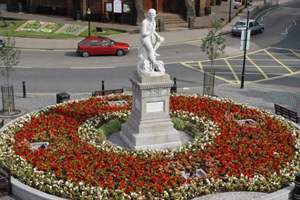
Dumfries (from the Scottish Gaelic Dùn Phris which means “Fort of the Thicket”) is a market town and former royal burgh within the Dumfries & Galloway council area of Scotland, situated close to the Solway Firth near the mouth of the River Nith. People from Dumfries are known colloquially as Doonhamers. The town is the burial place of Robert Burns, Scotland’s national poet. During its first 500 years English armies sacked, plundered or occupied the town in 1300, 1448, 1536, 1542, 1547, 1570 and 1640. In the invasion of 1300, Edward I lodged for a few days in June with the Minorite Friars of the Vennel, before at the head of the then greatest invasion force to attack Scotland he laid siege to Caerlaverock Castle. Robert Burns moved to Dumfriesshire in 1788 and Dumfries itself in 1791, living there until his death on 21 July 1796. Today's Greyfriars Church overlooks the location of a statue of Burns.
Old Bridge House Museum
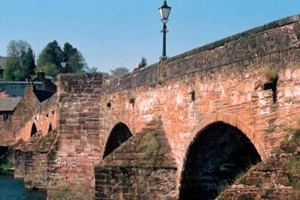
Attached to the fifteenth century Devorgilla Bridge in Dumfries is the Old Bridge House, built in 1660 and is Dumfries' oldest house - now a museum of everyday life in the town. The bridge, named after Devorgilla, the wife of King John Balliol, founder of Balliol College, Oxford, was built in 1432 and is still used by pedestrians. It is one of Scotland's oldest standing bridges.
Admission is free.
www.undiscoveredscotland.co.uk/dumfries/oldbridgehouse
Robert Burns House, Dumfries
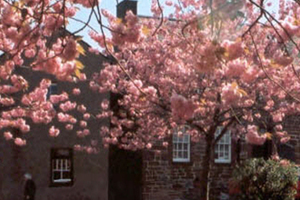
Robert Burns House has attracted many famous visitors including the poets Wordsworth, Coleridge and Keats and is now a place of pilgrimage for Burns enthusiasts across the world.
Admission is free.
www.burnsscotland.com/venues/dumfries/house
The Globe Inn
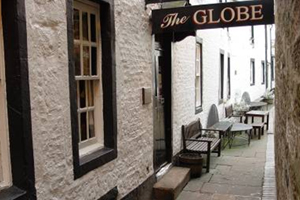
Established in 1610, The Globe Inn, Dumfries has long been associated with Robert Burns. In 1819, the first of what was to become the annual tradition of Burns Suppers was held at this howff (or haunt). The Globe Inn is an important historic pub, steeped in the history of Robert Burns and Dumfries and every corner is packed with fascinating memorabilia. And beware, it is said to be haunted!
Dumfries Aviation Museum
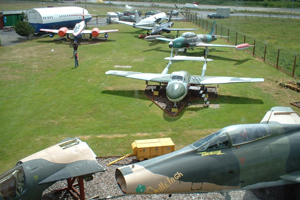
The restored Control Tower of the former WWII airfield at Dumfries is the centrepiece of the Museum and is now a listed building. The Museum houses a large aircraft collection, aero engines and a very impressive display of artefacts and personal histories relating to aviation, past and present. Both civil and military are represented. A new display representing aviation in Scotland and a mock-up of a WWII living room are now complete.
Admission charges apply.
www.dumfriesaviationmuseum.com
The River Nith
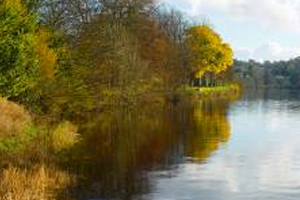
The Nith rises in the Carsphairn hills of East Ayrshire and flows through the Nithsdale region, passing through Dumfries and discharging into the Solway Firth at Ards point. The estuary near to Hutton Lodge is an important site for wildfowl, and is an internationally protected conservation area. The area is a Site of Special Scientific Interest and is within the Caerlaverock National Nature Reserve.
Crichton Estate
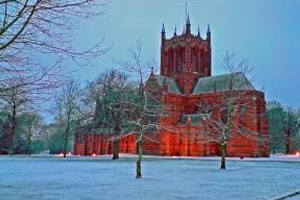
These beautiful grounds covering 34 hectares just 5 miles from Hutton Lodge are landscaped with mature rhododendrons, azaleas and many tree specimens together with a large rock garden, waterfall and ornamental pond. Access to the gardens is free. In 1839 the Crichton family built a lunatic asylum on the site as well as an imposing family church. The buildings are used today as a business park, university campus, church and hotel.
Read the fascinating account of the Crichton estate at www.marysmith.co.uk/Crichton.pdf
Dock Park

The Dock Park, covering 9 hectares (22 acres), is on the south side of the River Nith in Dumfries. A memorial to HMS Titanic can be found here commemorating the loss of two residents of Dumfries, one of whom played in the band on board the ill-fated liner. The park was often used by Robert Burns to unwind and relax by strolling along the banks of the river, something we often do ourselves in these tranquil surroundings.
Drumlanrig Castle

Drumlanrig Castle (1691) is an ancient Douglas stronghold and Dumfriesshire home of the Duke & Duchess of Buccleuch and Queensberry. Set on the spectacular 90,000 acre Queensberry Estate it is an example of late 17th century Renaissance architecture, housing the Buccleuch art collection which includes Rembrandt’s ‘An Old Woman Reading’, and Leonardo Da Vinci's ‘Madonna of the Yarnwinder’ (stolen in 2003 and recovered in 2007) and many other paintings, tapestries and objects of art. There are marked paths and woodland trails for wildlife enthusiasts, walkers and mountain bikers including field sports and fishing. There is the Castle Shop, Stable Yard Studios, Visitor Centre, the Scottish Cycle Museum and the Castle Tearoom serves home baked food sourced from the estate.
The Kelpies
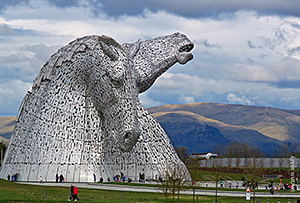
Standing 30 metres high, these horse-head sculptures by Andy Scott are built of structural steel and clad with stainless steel. They stand in The Helix complex alongside the Forth and Clyde Canals 110 miles from our home and represent the lineage of the heavy horse of Scottish industry.
www.thehelix.co.uk/things-to-do/the-kelpies
Sweetheart Abbey

Sweetheart Abbey was built in memory of John de Balliol by his wife Devorgilla, the daughter of Alan, Lord of Galloway, who founded this Cistercian monastery in 1275. His embalmed heart, kept in a casket of ivory and silver, was buried in the Abbey alongside her when she died. The monks at the Abbey then renamed the Abbey in tribute to her.
www.undiscoveredscotland.co.uk/newabbey/sweetheartabbey
Stake Nets on the Solway
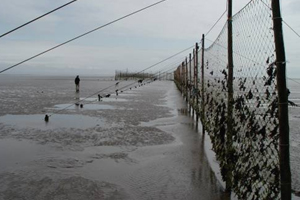
A number of fishing methods are used to catch salmon and other species along the Solway, and one of them is the stake net, seen here at low tide near Sandy Bay.
Walks from Kippford village
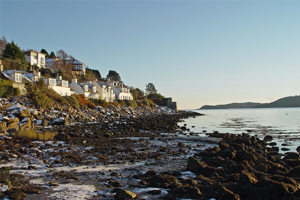
Walks from Kippford village have a network of minor paths to Rockcliffe village. A detour takes you onto the top of the Roman fortification known as the Motte of Mark for an excellent view of the Rough Firth estuary. At low tide, you can walk across the exposed causeway to Rough Island, but beware you don’t get caught by the incoming tide!
www.undiscoveredscotland.co.uk/dalbeattie/rockcliffe
Rockcliff
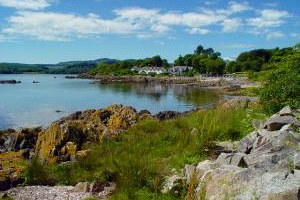
Rockcliff is linked to Kippford by a scenic track, known as the Jubilee footpath, which passes parallel to the coast with another path at a higher elevation that can be used to access Mark hill (locally known as the Muckle) and the Mote of Mark, a 5th-century hill fort. Remember to walk across to the small uninhabited Rough Island when the tide is low.
Cairnholy
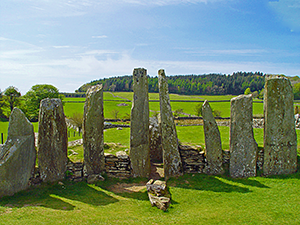
Cairnholy is located near the farm of the same name just off the A75 between Gatehouse of Fleet and Creetown along the Solway Coast. Dating back to over 4000BC the site is well worth a visit.
Free admission.
www.undiscoveredscotland.co.uk/gatehouseoffleet/cairnholyii
Crawick Multiverse
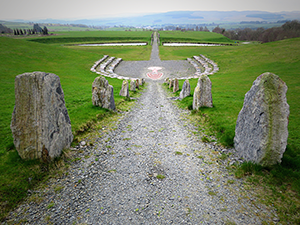
Designed and constructed by Charles Jencks, this project is located near to Sanquhar, 33 miles from Hutton Lodge on the site of a former open cast coal mine. Covering 55 acres, it is a representation of modern cosmology and includes two stone circles representing the Milky Way and Andromeda galaxies.
Criffel
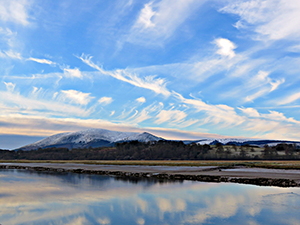
Stands 570 metres above the Solway near the River Nith estuary and is a popular climbing venue that provides spectacular views from the summit. It is an extinct volcano from over 300 million years ago and the distinctive conical shaped vent, known as Knockendoch, can be scaled as a subsidiary climb. Nearby, the Waterloo Monument is located on a walking trail above New Abbey, All within 13 miles from Hutton Lodge.
www.themountainguide.co.uk/scotland/criffel.htm
Grey Mare's Tail
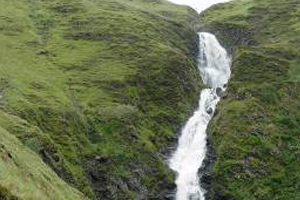
Grey Mare's Tail is a 60-metre (200 ft) hanging valley waterfall near to Moffat. It is produced by the Tail Burn flowing from Loch Skeen cascading into the Moffat Water in the lower valley below. The surrounding area forms the Grey Mare's Tail Nature Reserve. The footpath from the valley floor up to Loch Skeen is one of the more popular walks in the area.
Parking is provided.
www.visitmoffat.co.uk/attraction-finder/the-grey-mares-tail
St Ninian’s Cave
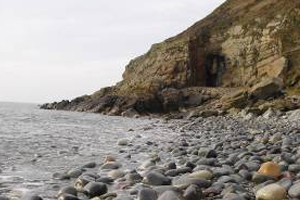
St Ninian was first mentioned in the 8th century as being an early missionary among the Pictish peoples of what is now Scotland, converting them to Christianity. After his death in 432AD he is buried at Whithorn. St. Ninian’s Cave is said to have been his retreat where an incised cross was found in 1871 and excavations in 1884 revealed a number of crosses now removed to the Historic Scotland Museum in Whithorn for safe-keeping. The Catholic Diocese of Galloway annually holds a pilgrimage to St. Ninian's Cave on the last Sunday in August.
www.whithorn.com/history-local-sites.asp?localsiteID=8
Twelve Apostles
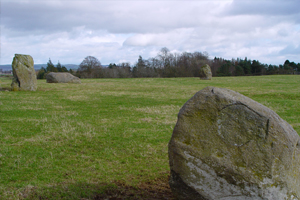
Twelve Apostles is the name given to a large stone circle situated between the villages of Holywood and Newbridge, near Dumfries. It is the fifth largest stone circle in Britain and the largest on the mainland of Scotland.
Admission is free.
www.en.wikipedia.org/wiki/Twelve_Apostles_Stone_Circle
Threave Castle
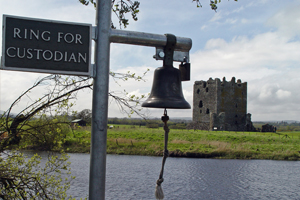
Threave Castle stands on an eyot in the River Dee. Built in the 1370s as a stronghold of the Black Douglas’s, it has at its base an artillery fortification built before 1455 when James II besieged the castle. A boatman takes visitors across to the castle, but in winter it is almost inaccessible.
www.undiscoveredscotland.co.uk/castledouglas/threavecastle
The Garden of Cosmic Speculation
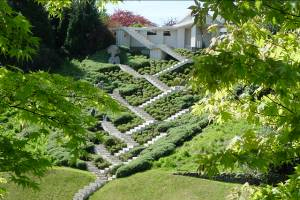
This private sculpture garden was created by landscape architect and theorist Charles Jencks at his home, Portrack House off the A76 north of Dumfries. The garden is inspired by science and mathematics, with sculptures and landscaping on these themes which elegantly combine natural features and artificial symmetry and curves. It opens on one day each year and raises money for Maggie's Centres, a cancer care charity named for Maggie Keswick Jencks, the late wife of Charles Jencks.
www.charlesjencks.com/#!the-garden-of-cosmic-speculation
Striding Arches

Travel to Moniave to see the free standing sandstone structures known as the Striding Arches created by world-renowned artist Andy Goldsworthy. Mined from Locharbriggs quarry, these large Dumfriesshire sandstone blocks form impressive self-supporting arches that have been erected around the hills of Cairnhead off the A702.
Sanquar Post Office

The world’s oldest working post office is found in Sanquar, a 30 mile drive north of Dumfries on the A76. Built in 1712, it is still in daily use.
www.undiscoveredscotland.co.uk/sanquhar/sanquhar
Durisdeer Church
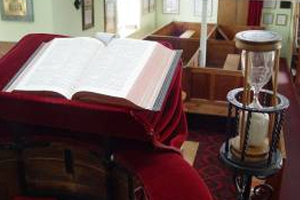
Durisdeer Church was built by the third Duke in the 1720s and includes the Queensberry Aisle, burial place of the dukes with a large marble monument to the second Duke (1662-1711) and Mary, his duchess. The pulpit has a large hourglass to remind the minister when it is time to wind down his sermon.
Admission is free.
www.undiscoveredscotland.com/durisdeer/durisdeer
The Falkirk Wheel
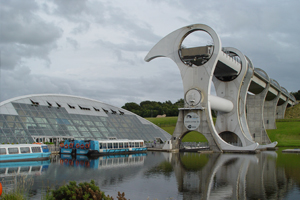
The Falkirk Wheel is an exceptional feat of modern engineering designed to reconnect the Forth and Clyde Canal and the Union Canal near Falkirk. This remarkable and elegant mechanical marvel is the only rotating boatlift in the world and truly one of a kind.

